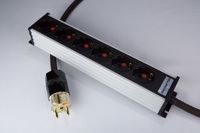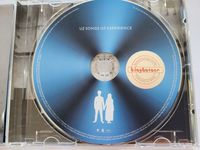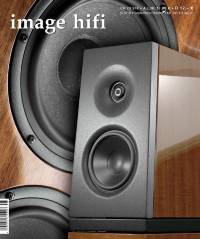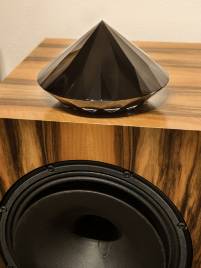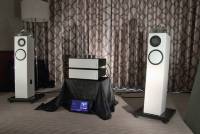Biophotone Audio Online Shop
Unser aktuelles Produkt-Portfolio - für die Übersicht einfach auf das Photo klicken
Beispielfoto 4
Bioiphotone AURUM Wood Lenses, Set á 10 Stück
Silicium-Ronden zum Aufbringen auf LS-Rückseiten und für das Innen-Tuning von Audio-Komponenten
Auf den Biophotone AURUM Wood Lens Rhodium CT kommen neben Rhodium und Platin und dem neu entwickelten AURUM Spektrum als Besonderheit die Schwingungsspektren der sogenannten „Klanghölzer“ zur Anwendung. Hierbei handelt es sich um eine Reihe von insgesamt 12 ausgewählten edlen Hölzern, die im klassischen Instrumentenbau verwendet werden und den gesamten Bereich Aerophone (Blockflöten, Querflöten, Panflöten, Rohrblattinstrumente), Chordophone Zupf (Gitarre, Laute, Mandoline, Theorbe, Banjo, Zither, Harfe), Chordophone Streich (Violine, Viola, Cello, Kontrabass, Gambe, Arpeggione) sowie Membranopohone (Trommeln, Bongos, Congas, Tambourin, Tom-Toms, Snaredrum, Pauke) uvm. abdecken. Die Eigenart eines Holzes begünstigt immer eine bestimmte Obertonstruktur, dies ist der Untergrund, den wir als „Holzklang“ wahrnehmen. So sind z.B. exotische Hölzer obertonreicher, sie sind auch etwas lauter, Palisander klingt rauh, Flötenbauer schwören auf europäischen Buchsbaum, Kirsche ist das bevorzugte Holz für tiefe Instrumente. Allerdings ist Holz eben auch immer verarbeitetes Holz, so wird Holz in Öl eingelegt, lackiert, gebohrt, unterschiedlich gelagert, all dies hat Auswirkungen auf den Klang. Deshalb das einzigartige Wood Lens Schwingungsspektrum, das geeignet ist, diese Einflüsse zu minimieren und den „wahren, reinen, unmittelbaren“ Klang des jeweiligen Holzes wieder hervorzubringen. Doch hören Sie selbst…
Perfektioniert wird die Obertonstruktur durch die zusätzliche Aufbringung des Schwingungsspektrums der sog. Chromatischen Tonleiter, einer Folge von allen verfügbaren Tönen als Folge von 12 Halbtönen (A, Ais/B, C, Cis, D, Dis, E, F, Fis, G, Gis, H). Damit wird die jeweilige Obertonreihe, die durch verschiedenste äussere Einflüsse beeinträchtigt oder gestört sein kann, komplettiert und ein grosses „C“ mit einer Frequenz von 66 Hz schwingt eben auch wieder mit 132 Hz, 198 Hz, 330 Hz, 396 Hz usw. Dies können Sie selber beim Spielen eines einzelnen Klaviertones wahrnehmen, wenn Sie konzentriert hinhören. Einzusetzen auf allen Audio-Komponenten wie für das Innen-Tuning.
Einsatzgebiet und Anwendung (Packungsgrösse Set á 10 Stück, Durchmesser ca. 2 cm):
Wahlweise mit den mitgelieferten Klebepads an glatten Oberflächen oder mit Haftmasse an Steckern wie RCA oder XLR bequem anzubringen. Der Einsatz in Geräten auf Elkos und Chips ist ebenfalls klanglich sehr gut hörbar. Im Chassis Innen wie auf der Platine. Desweiteren sind Lautsprechertreiber direkt bestückbar. Wir montieren die Wood Lenses auch im Stromkasten und an Kaltgerätesteckern.
In addition to rhodium and platinum and the newly developed AURUM spectrum, the Biophotone AURUM Wood Lens Rhodium CT features the vibration spectra of the so-called "tone woods". This is a series of a total of 12 selected precious woods used in classical instrument making and covering the entire range of aerophones (recorders, transverse flutes, panpipes, reed instruments), chordophones plucked (guitar, lute, mandolin, theorbo, banjo, zither, harp), chordophones bowed (violin, viola, cello, double bass, viola da gamba, arpeggione) and membranophones (drums, bongos, congas, tambourine, tom-toms, snare drum, timpani) and many more. cover. The peculiarity of a wood always favours a certain overtone structure, this is the background we perceive as "wood sound". For example, exotic woods are richer in overtones, they are also somewhat louder, rosewood sounds rough, flute makers swear by European boxwood, cherry is the preferred wood for low instruments. However, wood is always processed wood, so wood is soaked in oil, varnished, drilled, stored differently, all this has an effect on the sound. Hence the unique Wood Lens vibration spectrum, which is suitable for minimising these influences and bringing back the "true, pure, immediate" sound of the respective wood. But listen for yourself...
The overtone structure is perfected by the additional application of the vibration spectrum of the so-called chromatic scale, a sequence of all available tones as a series of 12 semitones (A, A sharp/B, C, C sharp, D, D sharp, E, F, F sharp, G, G sharp, B). This completes the respective overtone series, which can be impaired or disturbed by various external influences, and a big "C" with a frequency of 66 Hz also vibrates at 132 Hz, 198 Hz, 330 Hz, 396 Hz, and so on. You can perceive this yourself when playing a single piano note if you listen with concentration. To be used on all audio components as well as for interior tuning.
Field of application and use (package size: set of 10 pieces, diameter approx. 2 cm):
Can be conveniently attached to smooth surfaces with the supplied adhesive pads or to plugs such as RCA or XLR with adhesive mass. The use in units on electrolytic capacitors and chips is also very audible in terms of sound. Inside the chassis as well as on the circuit board. Furthermore, loudspeaker drivers can be mounted directly. We also mount the AURUM Wood Lens in the power box and on IEC plugs.
Zuzüglich Porto und Verpackung.
AGB
Lieferbedingungen
Hier geht's zu unserem Biophotone Audio Online Shop:
Biophotone Audio: Nur Live ist besser!
AKTUELL:
Neue "AURUM-SERIE ab sofort verfügbar!
Unsere mit so vielen Vorschuss-Lorbeeren bedachte "AURUM"-Serie löst nach mehreren Jahren und viel Entwicklungszeit unsere so erfolgreiche und von unzähligen begeisterten Kunden-Feedbacks begleitete "BLACK PEARL"- Serie ab. Hinzugekommen zum "BLACK PEARL"-Spektrum sind die Schwingungsfrequenzen von Gold, Iridium und Ruthenium. Gold und seine beiden Mitstreiter aus der Platin-Gruppe haben sich in unzähligen Tests als die ideale Ergänzung und Erweiterung unseres Biophotone-Spektrums erwiesen und verleihen unseren Produkten nochmals den sog. "Extra-Kick". Zum Nachrüsten wird für alle Kunden wieder ein Update-Chip mit Durchmesser 3cm und 4cm angeboten mit den drei zusätzlichen Schwingungen (im Shop unter "Specials"). Unsere neue "AURUM"-Serie ist ein weiterer Meilenstein in der Biophotone-Erfolgsstory. Ich wünsche ihnen viel Spaß und Freude damit! Ihr Oliver Rinaldi
Hinweis: Diese Website nutzt Cookies, um die beste Nutzererfahrung zu gewährleisten. Alle rechtlichen Infos dazu unter "Datenschutzerklärung" im Impressum.
JETZT NEU:
Tuning-Testpaket unverbindlich anfordern!
Teilen Sie uns mit, wie Ihre Kette aufgebaut ist (Komponenten / Fabrikate) und wir stellen Ihnen optimal darauf abgestimmt ein Biophotone-Audio Tuning-Paket zusammen, das Sie unverbindlich für 1 Woche ausprobieren und testen können. Einfach email schreiben und Versandadresse angeben. Wir melden uns innerhalb von 3 Werktagen bei Ihnen!
ENGLISH VERSION NOW AVAILABLE!
By popular request, we have added product descriptions in English now to all the products available in our online shop. So all products of the current series can be ordered easily, directly and quickly. See the main bar at the top centre. Just press "ONLINE SHOP" on top of page.
JETZT NEU:
High End Steckerleiste PS 10
Auf vielfachen Wunsch haben wir in Ergänzung unseres Kabel-Sortiments nun auch eine 6-fach Steckerleiste entwickelt. Die Steckerleiste PS 10 hat als Leitungszuführung das höchstwertige Netzkabel P10. Durch eine genial einfache Konstruktion kommen die im Gehäuse befindlichen Kontaktleisten für Phase, Nullleiter und Erdung jeweils mit nur einer Klemmverschraubung aus, nämlich die, an der das Zuleitungskabel angeklemmt ist. Damit werden stromflusshemmende Leitungsübergänge auf ein Minimum reduziert. Zudem sind die Kontaktleisten frei von ferromagnetischen Elementen. Das Gehäuse ist zur elektromagnetischen Abschirmung von innen mit einer Kupferfolie beschichtet. Damit bildet die Steckerleiste eine perfekte Basis zur Stromversorgung einer High End Audio Anlage. Sie ermöglicht eine verzerrungsfreie Wiedergabe mit einer Fülle von Details und höchster Dynamik.
JETZT NEU:
Unsere Black Pearl CD/LP Harmonizing-Chips SLIM. Aus ultradünner Aluminium-Folie, selbstklebend, zum Aufbringen auf CDs und LPs.
Das Set á 10 Stück für € 19,90. Im Online-Shop unter "Phono, Vinyl+CD".
Ergänzung unseres Kabel-Sortiments im TOP-Segment:
Jetzt neu im Sortiment unsere High-End Top-Kabel LS 10 (Lautsprecherkabel), NF 10 (Cinch-Kabel), Digi 10 (Digital-Kabel) sowie USB 10 (USB-Kabel). Siehe auch u.a. Testbericht in IMAGE HiFI über unsere Kabel-Serie.
Online-Shop verfügbar!
Auf vielfachen Kunden-Wunsch haben wir unserer Audio-Site einen VK-Shop angegliedert, in dem alle Produkte der aktuellen Serie einfach, direkt und schnell bestellbar sind. Siehe Hauptleiste Oben Mitte.
NEU: Biophotone Black Pearl Serie!
Ab sofort sind alle Biophotone-Komponenten mit unserem neuesten Schwingungsspektrum "Black Pearl" versehen. Dies umfasst zusätzlich Thulit und Sugilith (zwei extrem kräftige Silikate), Tellurium (das aus der Kabelindustrie bekannt ist), Edel-Schungit gegen elektromagnetische Störfelder sowie den urspünglichen Kammerton 432 Hz, den harmonischen Grundstimmungs-Ton, auf den auch das Cortische Organ im Innenohr des Menschen gestimmt ist. Ein weiterer Meilenstein in der Biophotone-Forschung! Das neue Frequenzspektrum wurde erstmals verwendet in unserer neuen Kabel-Serie (siehe Testbericht IMAGE HiFi u.a.)
Für ein Update der Komponenten Ist ein Black Pearl Upload Chip verfügbar mit den 5 neuen Frequenzen (siehe Shop).
Testbericht über Biophotone "Black-Pearl"- Kabelserie in image hifi 05/18
Hier der Link zum Testbericht:
NEU:
Neues Biophotone "Black-Pearl" Kabelsortiment jetzt verfügbar!
Hier die Preisliste zum Download:
Das Highlight der neuen Black Pearl-Serie:
Black Pearl Diamant XXL!
Der Biophotone Black Pearl Diamant XXL:Universell einsetzbar auf Lautsprechern und allen Audio-Komponenten. Durchmesser 20 cm, Gewicht 4,5 KG! Ein sofortiges Mehr an Dynamik, Auflösung, Durchhörbarkeit und Detaillereichtum!
Bericht in der Allgäuer Zeitung über Oliver Rinaldi und Biophotone vom 30.06.2018:
Artikel%20AZ%2030-06-18%20(2).pdf
Westdeutsche Hifi Tage Bonn 2018:
Biophotone Audio mit Sauermann Vor- Endstufen und Myro Cellensis Lautsprechern:
Aktueller Bericht über Biophotone Audio in: Börse Online 31/2017:
"Im Hohlraumresonator versieht Oliver Rinaldi Kristalle, Metall- und Glasscheiben mit bestimmten Frequenzen. Auf Hifi-Komponenten aufgelegt, verbessern seine Produkte den Sound brachial."
Zitat:
"Goldmedaille für Sound Chips von Biophotone: Die Sound Chips sind einfach genial!"
-Die Biophotone Sound Chips, getestet in der aktuellen Ausgabe von audiophil-online-
Hier der Link zum Testbericht:
http://audiophil-online.de/hifitest/energiewirbel/biophotone-sound-chips.html
Biophotone Audio erhält den image hifi Award 2016 für den Magic Akasha X-Plosion.
Produktneuheiten:
____________________________________________
Der XXL-Diamant-jetzt auch für Lautsprecher!
Auf vielfachen Wunsch haben wir neben unserem XXL-Diamanten als Raum-Harmonizer jetzt auch eine Version für Lautsprecher geschaffen. Die Lautsprecher-Version beinhaltet neben unserem aktuellen Magic Aksha Frequenzspektrum auch das gesamte Wood Lens Spektrum unserer Wood Lenses (Holz-Instrumente und -Klänge). Einfach auflegen und staunen! Durchmesser 20 cm, Gewicht: 4,5 KG.
Cable Liner Slim
Ab sofort erhältlich: Die optimale Ergänzung zu unseren Cable Linern und Cable Sleeves: Die Cable Liner SLIM. Mit unserem mehrfach ausgezeichneten Cable-Sleeves Frequenzspektrum versehene Edelstahlstifte im Pocket-Format (10 x 0,9 cm), ideal zur Harmonisierung/Energetisierung aller hängenden Kabel. Im 3er Set incl. Kabelbinder.
Unsere mehrfach ausgezeichnete "Black Magic" Serie erhält Zuwachs:
____________________________________________
F-2 Black Magic
Jetzt neu: Der kleine "F-1". 1,1 KG, quadratisch. 15x15x1,5 cm. Schwarzglas mit aktuellem Magic Akasha Frequenzspektrum. Zum Auflegen auf kleinere Lautsprecher und Audio-Komponenten. Handgearbeitet von einer deutschen Glasmanufaktur.
___________________________________________
F-1 Black Magic
Unser "F-1" jetzt in neuem Design: 27,5x15,5x1,8 cm, 1,6 KG. Schwarzglas mit aktuellem Magic Akasha Frequenzspektrum. Zum Auflegen auf Lautsprecher und alle Audio-Komponenten. Handgearbeitet von einer deutschen Glasmanufaktur.
____________________________________________
F-1 Slim Line
Elegante flache Schwarzglas-Platte 26,5x26,5x1cm mit aktuellem Magic Akasha Frequenzspektrum (siehe u.a. Test Image hifi) zum Unterlegen unter alle Audio-Komponenten. Handgearbeitet von einer deutschen Glasmanufaktur.
____________________________________________
X-Plosion 33 1/3
Der Energetisierer für Ihre Vinyl-Schätze -bringt frische Strahlkraft auf alle Scheiben. Edelstahl-Ronde 30x30x0,5 cm mit aktuellem Magic Akasha Frequenzspektrum (siehe Test Image hifi). "Handmade in Germany!"
Testbericht: Magic Akasha X-Plosion und Quantum Power Cable Sleeves
IMAGE HiFi
Testbericht: Quantum Power Plug
HÖRERLEBNIS
QPP%20H%C3%B6rerlebnis%2005.2015.pdf
___________________________________________
NEU: Service "Plattenteller-Tuning"
Von phänomenalen Kunden-Feedbacks begleitet sind die ersten Plattenteller-Tunings, die wir testweise vorgenommen hatten. Dabei wird der komplette Plattenteller bei uns in einen der Hohlraum-Resonatoren gegeben und mit dem aktuellen Magic Akasha Frequenzspektrum bespielt. Das Ergebnis lässt die glücklichen Besitzer vor Begeisterung Purzelbäume schlagen, ihr Plattenspieler ist nicht wiederzuerkennen und spielt plötzlich in einer ganz anderen Preisklasse. Aufgrund der vielen Weiterempfehlungen und Anfragen haben wir uns entschieden, diesen Service nunmehr offiziell anzubieten. Einheitspreis pro Plattenteller € 300,00 zzgl. Porto, egal, wie groß und schwer. Eine Einmal-Investition, die sich für jeden Audio-Liebhaber bezahlt macht. Schicken Sie uns Ihren Plattenteller oder bringen Sie ihn einem der gelisteten Biophotone-Händler. Bearbeitungszeit insgesamt ca. 10 Tage. Ihre Fragen dazu beantworten wir gerne.
Getunter Nottingham Analogue-Plattenspieler
___________________________________________Biophotone jetzt in Garrard-Turntables
Biophotone Magic Light Harmonizer in HÖRERLEBNIS Nr. 79
___________________________________________
Biophotone Raum-Harmonizer Programm in HÖRERLEBNIS Nr. 77
___________________________________________
Biophotone Quantum Power Cable Sleeves in HÖRERLEBNIS Nr. 76
___________________________________________
Biophotone ESE Effective Sound Enhancing System in HÖRERLEBNIS Nr. 72

